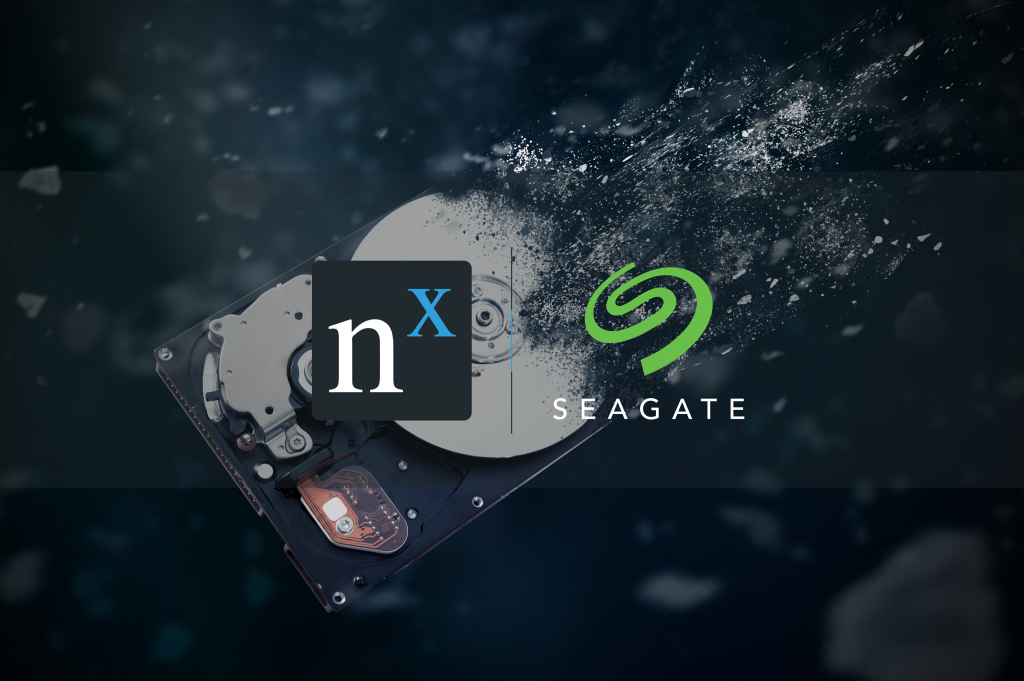
At the heart of every Nx powered video system sits storage. We teamed up with Seagate to learn more about its future.
In 2017 Seagate launched Data Age 2025 – a white paper exploring the implications of a ten-fold increase in the amount of data humanity creates.
Below we review the key trends and statistics identified in the Seagate Data Age 2025 report and why they matter to Nx and the AI-powered video industry moving forward.

Trend 1: We're going to generate a lot more data. Much of it video.
- Key Stats
According to International Data Corp. and Seagate, by 2016 humans had created 16 Zettabytes of data. Another way to say that is in 2016 humanity created enough data to fill 16 billion 1TB hard drives.
Seagate research predicts 10 times that amount by 2025 – 163 Zettabytes – or 160 billion 1TB hard drives.
- Why It Matters
Nx anticipates that much of the coming growth in the datasphere is going to be driven by the adoption and integration of live video and its associated metadatainto everything from retail analytics to production monitoring to autonomous vehicles and robotics.
Video is going to flow like digital water through our machines and networks. In order to take full advantage of the massive amounts of sensitive data that is going to be created expect hardware manufacturers to focus on speed, stability, and security.
Trend 2: More data is going to be created by companies than by individuals.
- Key Stats
Seagate & IDC categorized the types of devices creating data into Core (aka Cloud datacenters), Edge (aka local appliances / servers), and Endpoint (aka PC’s, phones, smart cars).
In 2017 Endpoint devices were responsible for 68% of data created. By 2025 the representation of Endpoint devices is expected to shrink to 52% – with Edge devices nearly doubling their share to 24%.
- Why It Matters
Our phones, cars, home automation devices (like Amazon’s Alexa) – Edge devices – are all going to be smarter (read: AI-enabled) and more powerful, with faster, more stable, and more secure storage.
We can observe this trend happening in real time in the security surveillance industry today. IP cameras today often include built-in storage and basic in-camera analytics as standard features. And some already support AI that runs on the camera itself.
Trend 3: More data is going to be stored by companies than by individuals.
- Key Stats
In their research Seagate & IDC categorized data storage locations into 4 categories – Mobile (aka on your phone or tablet), Enterprise (aka in companies, government, NGOs private systems), Entertainment (aka VDs, Blu-ray Discs), and PC (aka personal computing devices).
- In 2010 Entertainment represented 50% of data stored. (Just 8 years ago half of the world’s data was written onto plastic discs.)
- By 2025 Entertainment will drop to 21% – replaced by Mobile (12%,) and Enterprise (57%) storage.
- Why It Matters
Companies, not individuals, are going to be creating and storing most data. Probably as an extension of their existing product, and probably as a recurring service.
Users will have the ability to reduce their capital expenditures (up front costs of buying computing and storage hardware), improve the availability of their data(cloud) and increase the efficacy and archive periods of their captured video by using AI to capture only what is really important.
Trend 4: Data is becoming life-critical.
- Key Stats
One of the most interesting stats in the report is the emergence of life-critical data. This is a major development.
- IDC estimates that by 2025, nearly 20% of the data in the datasphere will be critical to our lives and 10% of that will be hypercritical.
- Why It Matters
Storage failure can cause significant disruption to a person’s life – sometimes deciding the difference between life and death.
To quote the IDC report “It’s one thing to lose a spreadsheet because of a PC crash; it’s another to cause physical harm because of errant data in a self-driving car.”
From a video industry perspective we are going to see systems and devices emerge with stability and speed as their primary feature sets. Video is going to transition from an event review technology to a valuable crisis prevention tool.
Trend 5: The world's going to get a lot more embedded IoT devices.
- Key Stats
Seagate & IDC’s research indicates what we all already know – we are going to be surrounded by Internet-connected gadgets reporting happily back to datacenters.
- The number of embedded system devices feeding into datacenters is less than one per person globally today but over the next 10 years that number will increase to more than four per person.
- By 2025 embedded data will constitute nearly 20% of all data created — three quarters the size of productivity data and closing fast.
- The average rate per capita of data-driven interactions per day is expected to increase 20-fold in the next 10 years as our homes, workplaces, appliances, vehicles, wearables, and implants become data enabled.
- Why It Matters
See Trend 2: IoT and Edge Devices are going to be everywhere, they’re going to be producing a lot of data, and we’re going to be interacting with them more.
As devices continue to get more affordable and more powerful, we’re going to see a larger variety of task-specific hardware make its way into our daily lives. From a video industry perspective – most new computing devices are going to be built video-enabled.
Trend 6: Real-time data is growing rapidly.
- Key Stats
- IDC estimates that by 2025, 75% of the world’s population will be connected to the Internet.
- Realtime data will grow at 1.5 times the rate of overall data creation.
- IDC estimates that the percentage of data in the datasphere that is processed, stored, or delivered by public cloud datacenters will nearly double to 26% from 2016 to 2025
- Why It Matters
The gap between what is Cloud and what is Local will continue to disappear.
In order for this to occur we can also expect Internet and Wireless Data speeds are going to increase rapidly.
From a video industry perspective, faster and broader Internet connectivity will enable simpler, cheaper offsite backup and distributed Cloud-enabled systems that can scale to millions of cameras – all tied together to provide unmatched situational awareness to users.
Trend 7: Data security as a critical core technology.
- Key Stats
- IDC estimates the percentage of data requiring security will near 90% by 2025.
- Enterprises must face the challenge of managing more than 97% of the global datasphere by 2025.
- Why It Matters
Combining video with AI to create actionable data is going to require the emergence of new technologies where data security is innate.
Seagate’s Secure technology – which enables self-encrypting hard drives, instant erase, and more – are a good example of a technology company taking a proactive approach to making it simpler for companies to protect the data of individuals.
From a video industry perspective we are likely to see the implementation of encrypted video codecs and smarter, more secure authentication methods.


